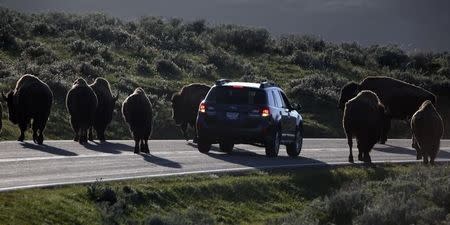Groups urge more room for Yellowstone bison to roam, end to severe culling
By Laura Zuckerman (Reuters) - Yellowstone National Park bison should be allowed to roam public lands in adjacent Montana without being marked for death to appease ranchers worried the animals will transmit the disease brucellosis to cattle, conservation groups said in a report released on Wednesday. The report by the National Parks Conservation Association, National Wildlife Federation and Wildlife Conservation Society comes after the National Park Service closed a public comment period on proposals to retool policies that have seen thousands of purebred buffalo from the nation’s last wild herd killed since 2000. The management plan crafted 15 years ago opens the way for bison that wander into Montana in winter searching for food to be killed to prevent transmission of brucellosis to a smattering of cow herds that graze in the region. Roughly half of Yellowstone bison have been exposed to the bacterial disease, which can cause cows to miscarry. Ranchers fear an outbreak would threaten the state’s brucellosis-free status, which lets cattle be sold across state lines without expensive testing. The conservationists' report draws on scientific studies and government data to conclude there is no evidence of brucellosis transmission in the wild from Yellowstone bison to cows. Elk have been named the culprit in the relatively rare occurrences in which Montana cows have tested positive for brucellosis. Yet elk are not herded back into the park or shipped to slaughter like bison, the conservation groups argued. “We need to manage bison the same way we manage other wildlife,” said Bart Melton, Northern Rockies regional director for the National Parks Conservation Association. That includes providing bison more room to roam on Forest Service lands in Montana bordering the park, where the iconic hump-shouldered creatures could remain year-round instead of being pushed back inside Yellowstone each spring, the report said. Bison once numbered in the tens of millions west of the Mississippi, but extermination campaigns in the late 19th century cut their numbers to fewer than 50 that found refuge at Yellowstone. They have since rebounded, and the buffalo are a top draw for the millions of tourists who annually visit a park that stretches across parts of Wyoming, Montana and Idaho. Bison managers floated new policy options in March ranging from increasing the number of buffalo at the park without severe culling to a proposal that could see many more killed each year. There is no timeline for a decision. (Reporting by Laura Zuckerman in Salmon, Idaho; Editing by Cynthia Johnston and Peter Cooney)




